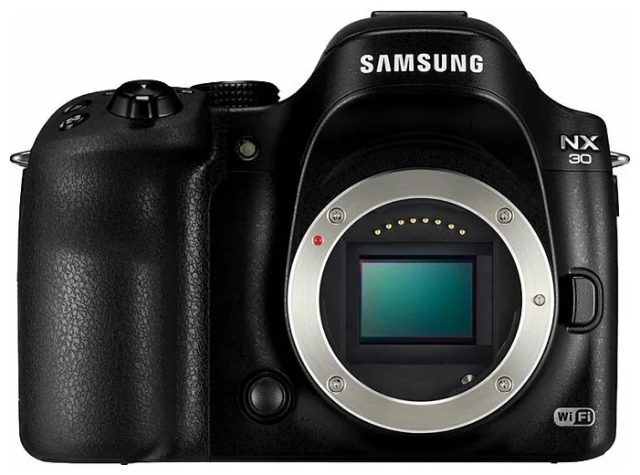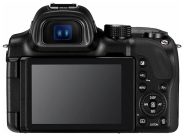Announced
Production status
System
Samsung NX30
APS-C AF digital mirrorless camera • Discontinued
Specification
| Format: | |
| APS-C | |
Imaging sensor: | 23.5 × 15.7mm CMOS sensor |
Resolution: | 5472 × 3648 - 20 MP |
Crop factor: | 1.53x |
Sensor-shift image stabilization: | - |
| Samsung NX [25.5mm] | |
| Shutter: | |
Type: | Focal-plane |
Model: | Electronically controlled |
Speeds: | 30 - 1/8000 + B |
| Exposure: | |
Exposure metering: | Through-the-lens (TTL), open-aperture |
Exposure modes: | Programmed Auto |
| Aperture-priority Auto | |
| Shutter-priority Auto | |
| Manual | |
| Physical characteristics: | |
Weight: | 375g |
Dimensions: | 127x95.5x41.7mm |
Manufacturer description
SEOUL, Korea – January 02, 2014 – Samsung Electronics Co., Ltd announced today the professionally-inspired NX30 compact system camera, featuring high quality images and with faster than ever performance. Samsung also expanded its line of NX lenses with the introduction of its first “S” Series premium lens.
"The NX30 continues the evolution of our award-winning NX series of cameras, bringing with it new and improved features such as a better imaging processor and our advanced SMART Camera offering. Not only does this camera deliver the performance users demand, it is also easy-to-use so that moments are never missed,” said Myoung Sup Han, Executive Vice President and Head of the Imaging Business Team at Samsung Electronics. "The NX30 allows photographers to shoot with confidence, providing a seamless ability to capture moments and share them immediately, delivering exceptionally beautiful photographs while creating an unmatched photo-sharing experience.”
Image Quality at the Core
High quality images with rich color are guaranteed with the advanced 20.3MP APS-C CMOS Sensor. Delivering shots that are bursting with sharp detail and intense colors, the large sensor is ideal for creating rich images with dramatic foreground and background blur, providing professional quality imaging that ignites the visual senses. Featuring the Samsung NX AF System II that boasts fast and accurate auto focusing, this new model ensures all moments, including fast-moving scenes and subjects that make up the beauty of everyday life, will never be missed.
Capturing short-lived, fast-paced moments in perfect clarity is achievable with the NX30's exceptionally fast 1/8000 sec Shutter Speed and the 9 frame per second (FPS) Continuous Shooting function. These features help to further break down the action and capture movement beyond what the eye can see so that each split second can be appreciated.
Featuring a unique, Tiltable Electronic Viewfinder (XGA, 2,359K-dot resolution), the NX30 makes it easier than ever to discover a new perspective. Whether crowds are obstructing the shot or a more creative angle is desired, the 80 degree tilt means that different viewpoints are simple to achieve. With the ability to move from side to side up to 180 degrees, and upward and downward up to 270 degrees, the NX30's 76.7mm (3.0-inch) Super AMOLED Swivel and Touch Display offers flexible angles which are especially useful for self-shooting, whether for stills or video capture.
Smart Connectivity, Tag & Go
Building on the successes of Samsung's market leading SMART Camera technology, the NX30's NFC and Wi-Fi capabilities offer the next-generation of connectivity, making it is easier than ever to take advantage of a host of intuitive sharing features. The ‘Tag & Go’ function lets users tap and share memories instantly and easily, pairing the NX30 with NFC enabled smartphones and tablets.
The Photo Beam feature allows the transfer of an image or video to a smartphone or tablet by simply touching the two devices together with no other configuration needed. MobileLink lets users select multiple images to send to four distinct smart devices at one time, so everyone can treasure photos without the need to take repetitive shots on each individual device. AutoShare automatically sends every photo you take instantly to your smartphone or tablet and the Remote Viewfinder Pro function enables control of the NX30 from a smartphone, allowing the user to zoom and snap shots remotely yet still have full visibility of the scene, opening up new photographic possibilities. Manual settings can still be accessed, including shutter speed and aperture, so that photographers can retain camera control yet have another option as to how they want to frame their shot.
Dropbox, the popular web storage service is pre-loaded on the NX30 in selected regions – making it the first camera-specific device to offer direct-to-Dropbox uploading. Additionally, users of the NX30 in select regions can upload directly to Flickr, the full resolution photo sharing site – another first in a camera-specific device. Using the advanced connected features of the NX30, images can be uploaded automatically so that snap happy photographers will not need to be concerned with filling up their memory cards ever again.
Experience Life from all Angles
The NX30 includes the sophisticated next-generation DRIMeIV Image Processor and a powerful DSP imaging engine that brings an unmatched shooting experience and Full HD 1080/60p movie capabilities. The high light sensitivity of the NX30, with a range from ISO100-25600, produces stunning images even in low light conditions and with OIS Duo technology, steady shots for better movie recording are guaranteed, even while on the move. The innovative technology provided by the DRIMeIV Image Processor also enables the 3D capture of scenes and subjects via the Samsung 45mm F1.8 2D/3D lens, letting memories live on through lifelike 3D images and videos displayed on compatible 3D devices. The introduction of OLED Color to the NX30 records the ultimate contrast and real colors, to make it possible for you capture landscapes that are rich and portraits with natural tones.
Advanced video features make the NX30 the ideal solution for movie makers searching for a compact yet high performing camera. In addition to Full HD Video Stereo Recording, the NX30 supports a standard 3.5mm microphone input for high quality audio capture while shooting movies. The Audio Level Meter appears on the display so you can continuously monitor the input level status while recording. In addition, the input level can be manually adjusted to ensure optimal audio quality. Moreover, the NX30 is also perfect for advanced video enthusiasts because of its HDMI live streaming with Full HD 30p output that makes it easy to connect with a large screen, recorder, and other HDMI devices.
Intuitive design is a central feature of the NX30. Two dedicated Custom Modes can be accessed on the mode dial, so that preferred camera settings can be retrieved quickly, while ten additional custom settings can be stored on the camera. The separate drive dial also provides instant access to a selection of popular modes, including continuous shooting, bracketing and self timer. It is therefore fast and simple to select the ideal settings for a shot, meaning that there is no delay in capturing the perfect image.
Through Samsung's innovative i-Function system, advanced camera settings such as shutter speed and aperture can be accessed with the touch of one button. For more experienced photographers, i-Function Plus lets users are able to reprogram existing buttons with their preferred and frequently used settings.
The powerful new SEF 580A TTL external flash with a Guide Number of 58 makes it simple to capture perfect shots, allowing light to travel further and wider. The high speed flash sync mode allows for flash with shutter speeds faster than 1/200 of a second, ideal for brightly lit scenes with selective depth of field. Additionally, this new flash supports wireless strobe sync, bringing an added dimension to images with light that looks natural.

